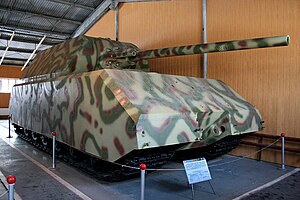Panzer VIII Mauschen: Difference between revisions
No edit summary |
No edit summary |
||
| Line 19: | Line 19: | ||
|unit_cost= | |unit_cost= | ||
|production_date = 1939-1945 | |production_date = 1939-1945 | ||
|number = 250 (of which | |number = 250 (of which 80 incomplete) | ||
|variants= | |variants= | ||
<!-- General specifications --> | <!-- General specifications --> | ||
Revision as of 05:06, 2 May 2023
| Panzer VIII Mauschen | |
|---|---|
 The only surviving Mauschen prototype at the Atalmar Tank Museum, Alteria | |
| Type | Super-heavy tank |
| Place of origin | Autocratic East Europan Imperial Alliance |
| Service history | |
| In service | 1942-1945 |
| Wars | Second Europan War |
| Production history | |
| Designer | Ferdinand Walther |
| Produced | 1939-1945 |
| No. built | 250 (of which 80 incomplete) |
| Specifications | |
| Weight | 200 tonnes (220 short tons; 200 long tons) |
| Length | 10.2 metres (33 ft 6 in) |
| Width | 3.71 metres (12 ft 2 in) |
| Height | 3.63 metres (11 ft 11 in) |
| Crew | 6 (commander, gunner, 2 loaders, driver, radio operator) |
| Armour | 220 mm (8.7 in) (turret front) 200 mm (7.9 in) (turret side and rear) |
Main armament | 128 mm (5 in) KwK 44 gun L/55 (68 rounds) |
Secondary armament | 75 mm (3 in) KwK 44 gun L/36.5 (co-axial) (100 rounds) |
| Engine | (V1) MB509 V12 petrol engine, DB 603 derivative (V2) MB 517 V12 diesel engine (V2) (V1) 1,080 hp (805 kW) (V2) 1,200 hp (895 kW) |
| Power/weight | 6.4 HP/ton |
| Ground clearance | 500 mm (20 in) |
| Fuel capacity | 2,700 litres (590 imp gal; 710 US gal) (internal fuel tank) 1,500 litres (330 imp gal; 400 US gal) (external fuel tank) |
Operational range | 160 km (99 mi) (road) 62 km (39 mi) (off road) |
| Speed | 20 km/h (12 mph) (maximum) 18 km/h (11 mph) (average road speed) |
The Panzer VIII Mauschen was an East Europan Super-heavy tank designed during the Second Europan War. It was the largest tank ever built and the heaviest tank made at 200 tons.
Construction began in 1939. Building the tank itself was difficult and consumed double the amount of materials needed to make 2 Panzer VI Tiger tanks. Its sheer weight, backed by its low acceleration and speed was its biggest drawback. Only 250 were ever made with more than 80 units ordered by the Empire of Quenmin with 80 units incomplete. Its expensive cost caused the Quenminese War Department to design its own indigenous super heavy tank project under supervision of Imperial Marshal Berthold Gregor Sr., the man behind the super heavy tank project. The Quenminese counterpart to the Mauschen was dubbed as the X-U Super heavy tank. Although the Quenminese had 2 other Mauschen derived inspirations through the X-O and X-I Super heavy tanks, these two superseded the Mauschen in size, such that the War Department was forced to cancel them, with the X-U being clandestinely built.
During tank encounters, the Maus was an effective weapon but by the time it was made, the Allies already developed the Centurion tank, which was a more versatile and advanced design, making the Maus obsolete. At the end of the war, the production of the Maus ceased. Today, only 1 surviving model is displayed at the Atalmar Tank Museum in Alteria.
The apex of Imperial tank designs became the Panzer IX Gnat, which itself was a battleship on land and was five times heavier than the Maus.
History and Development
Service
Surviving sample
Users
The Mauschen was only fielded by the Autocratic East Europan Imperial Alliance and the Empire of Quenmin. The Archadian Empire at first expressed interest but through studies made by its War Department deemed the Mauschen too inappropriate with the evolving mobile warfare.
- Autocratic East Europan Imperial Alliance: 170 units (60 incomplete)
- Empire of Quenmin: 80 units (20 incomplete)